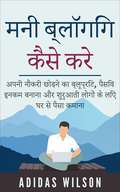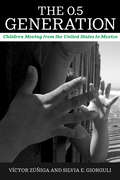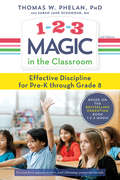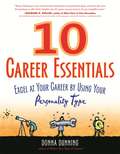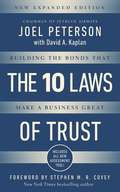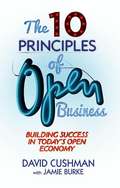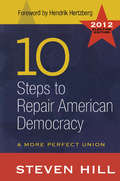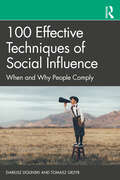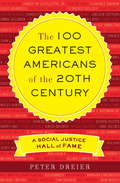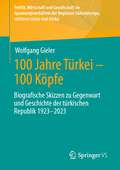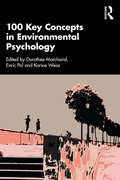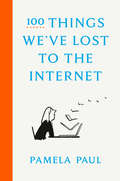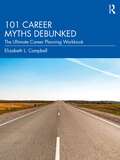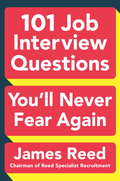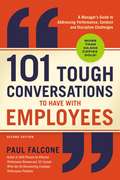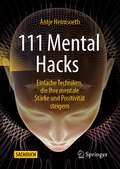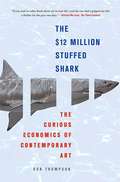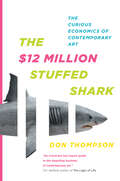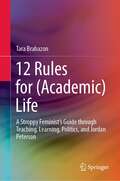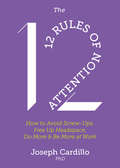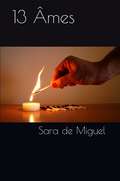- Table View
- List View
मनी ब्लॉगिंग कैसे करे: अपनी नौकरी छोड़ने का ब्लूप्रिंट, पैसिव इनकम बनाना और शुरुआती लोगों के लिए घर से पैसा कमाना
by Adidas Wilsonब्लॉग ऑनलाइन पत्रिकाओं के रूप में शुरू हुए जहां लोगों ने अपने जीवन को साझा किया। लेकिन आज, लक्ष्य अधिक पेशेवर हैं। अधिकांश लोग अब अपने व्यवसाय या ब्रांड को बढ़ावा देने के लिए ब्लॉग करते हैं। यह पोस्ट ब्लॉगिंग के सामान्य कारणों और लाभों पर प्रकाश डालती है। लोगों को जो पसंद है उसे साझा करना पसंद करते हैं। यदि आप मछली पकड़ना पसंद करते हैं, तो आप पूरी दुनिया को इसके बारे में बताना चाहेंगे। यह अन्य चीज़ों जैसे कि मार्केटिंग, फ़ोटोग्राफ़ी आदि के लिए जाता है, ब्लॉगिंग के बारे में जो आप प्यार करते हैं वह आपको दूसरों के साथ जुड़ने में मदद करता है जो आपके जुनून को दुनिया भर में साझा करते हैं। एक ब्लॉग आपको दूसरों को सिखाने के लिए एक मंच देता है। जैसा कि आप ऐसा करते हैं, आप इस विषय के बारे में अधिक जानेंगे। एक ब्लॉग के माध्यम से शिक्षित करना आपके लिए आय की एक धारा खोल सकता है।
The 0.5 Generation: Children Moving from the United States to Mexico
by Dr. Víctor Zúñiga Dr. Silvia E. GiorguliAt the beginning of the twenty-first century, a generation of children crossed the border from the United States to begin their lives anew in Mexico. While all were international migrants, their roots spread far and wide. Some were migrant returnees born in Mexico; others had only ever known a life in the United States. Distinguishing returnees from new arrivals seems simple, but defining these youths' affiliations in their new homes in Mexico is much more complex and yields new insights that enrich our contemporary understanding of inclusion and belonging. This book is the product of twenty-five years' worth of fruitful interdisciplinary dialogue and research on these children's trajectories, tracing their journeys and studying integration—or lack thereof—into Mexican society and institutions.
1-2-3 Magic in the Classroom: Effective Discipline for Pre-K through Grade 8
by Thomas Phelan Sarah Jane SchonourBased on the bestselling parenting book 1-2-3 Magic"If you only have time to read one book about managing student behavior, make it this one.""This book is a great resource for new teachers and veteran teachers."The fastest way to get back to what you love--teaching!Being a teacher can be one of the most rewarding professions, but also one of the most frustrating. Many teachers feel very prepared to instruct students in their chosen subjects, but don't have quite as much training in managing classroom discipline-yet experienced educators know that if challenging behavior goes unchecked, the entire year can be disrupted. 1-2-3 Magic in the Classroom shows teachers how to establish and maintain good discipline habits in their classrooms through an easy-to-understand program that you'll swear "works like magic."1-2-3 Magic in the Classroom will help you understand: How to encourage courteous classroom behavior and constructive work habits How your personality affects your teaching style How to effectively manage transition times with your class Successful methods for handling assemblies, recess, lunchtime, and field trips How to communicate productively with parents1-2-3 Magic in the Classroom takes the guesswork out of classroom discipline and will help you get back to teaching and your students get back to learning-today!
1 Way 2 C The World
by Marilyn WaringMarilyn Waring is a truly absorbing figure known as a distinguished public intellectual, a leading feminist thinker, environmentalist, social justice activist, and for her early political career after election to New Zealand's parliament at age twenty-three. Assembling some of her most thought-provoking writings, 1 Way 2 C the World is a compelling collection of essays and reflections on many important issues of our time. Written in lively, crisp, and often humourous prose, Waring provides illuminating commentary on topics such as gay marriage, human rights, globalization, the environment, and international relations and development. Including accounts of being in India at the time of Indira Gandhi's assassination, and in Ethiopia's during the 1984 famine, Waring's vivid writing remains contemporarily relevant, while this collection includes recent writings on the post-9/11 world. Brimming with pieces that are essential reading for anyone concerned with the state of the world, 1 Way 2 C the World is bound to fascinate and inspire.
10 Career Essentials: Excel at Your Career by Using Your Personality Type
by Donna DunningFocusing on day-to-day behaviors, as well as practical tips and strategies, author Donna Dunning shows readers how to make the most of the 80,000 hours the average person spends at work. Dunning provides key self-assessment tools and tips, allowing each individual to improve and implement their career strategy based on their personality type.
10 Laws of Trust, Expanded Edition: Building the Bonds that make a Business Great
by Joel PetersonJetBlue Chairman Joel Peterson provides the playbook for establishing and maintaining a culture of trust that breaks down the operational silos and CYA mentality that plague many organizations, in this groundbreaking expanded edition of The 10 Laws of Trust.Trust is the glue that holds an organization together. It turns deflection into transparency, suspicion into empowerment, and conflict into creativity. With it, a tiny company like John Deere grew into a worldwide leader. Without it, a giant corporation like Enron toppled.In The 10 Laws of Trust Expanded Edition, JetBlue chairman Joel Peterson explores how a culture of trust gives companies an edge.How does it feel to work for a firm where leaders and colleagues trust one another? Freed from micromanagement and rivalry, every employee contributes his or her best. Risk-taking and innovation become the norm. And, as Peterson notes, “When a company has a reputation for fair dealing, its costs drop: Trust cuts the time spent second-guessing and lawyering.”With compelling examples, Peterson details how to establish and maintain a culture of trust, including: Start with integrity * Invest in respect * Empower everyone * Require accountability * Create a winning vision * Keep everyone informed * Budget in line with expectations * Embrace conflict * Forget “you” to become an effective leader * And more.With this book in hand, you’ll be able to plant the seeds of trust—and reap the rewards of reputation, profits, and success.This fully expanded edition includes a powerful self-assessment tool for organizations to evaluate their culture of trust and discover areas for improvement. Peterson has also added rich new case studies and chapters on the theme of betrayal, including how to manage and guard against it.
The 10 Principles of Open Business
by David Cushman Jamie BurkeThe 10 Principles of Open Business is a practical guide to organizational design for the Twenty-First Century. Using case studies, the authors define the 10 principles of open business that organisations must adopt to both survive and thrive, and provide a practical method to assess the reader's own organization.
10 Steps to Repair American Democracy: A More Perfect Union-2012 Election Edition
by Steven HillIn 10 Steps to Repair American Democracy Steven Hill addresses the problems plaguing the US political system, outlining his ten-step program to improve American democracy. He proposes specific reforms to give voters more choices at the ballot box, boost voter turnout, reduce Senate 'filibustering' and end excessive corporate dominance. In the face of mounting cynicism about the US political system, 10 Steps to Repair American Democracy is a refreshing blueprint for how to resurrect the Founders' democratic vision. It will change the way you think about US politics.
100 Bullshit Jobs
by Stanley BingThe scholarly discipline of Bullshit Studies has blossomed in the last several years, fertilized by a number of critical works on the subject and the growing importance of the issue across a wide range of professions. Now, best-selling author and lifelong practitioner Stanley Bing enters the field with a comprehensive look at the many attractive jobs now available to those who are serious about their bullshit and prepared to dedicate their working life to it. What, Bing inquires, do a feng shui consultant, new media executive, wine steward, department store greeter, and Vice President of the United States have in common? What, too, are the actual duties performed by a McKinsey consultant? Other than sitting around making people nervous? Could that possibly be his core function? Likewise, what does an aromatherapist actually do, per se? Sniff things and rub them on people, for big fragrant bucks? Is that all? The answer in all cases is "Yes." They all have bullshit jobs. These few, of course, are just the beginning. Across the length and breadth of this shrinking globe, skillful bullshit artists have secured pleasant, lucrative employment, and are enjoying themselves more than you are. In virtually every occupation, from Advertising to Yoga Franchising, lucky individuals who "work" in these coveted positions enjoy the best lives imaginable -- they are paid well, they rarely break a sweat, and their professions are highly respected, because nobody really knows what they do. At once funny, useful, and tolerably philosophical, this groundbreaking work takes a close look at 100 bullshit jobs -- the money they bring with them, the actual tasks and activities involved (if any), and famous and successful examples of each position, who will provide the neophyte with inspiration. Most crucially, Bing goes on to offer what others so far have not--a clear, concise strategy to help job-seekers at every level reach for that brass ring, knowing full well that it may be attached to the nose of a bull.
100 Effective Techniques of Social Influence: When and Why People Comply
by Dariusz Dolinski Tomasz Grzyb100 Effective Techniques of Social Influence provides a revolutionary look into the effectiveness of many techniques of social influence, providing an overview of the ways in which people use techniques to persuade others to meet various requests, suggestions, and commands. For each technique, the authors explore the idea behind it, what empirical research says about it, and what the psychological mechanism behind its effectiveness is, aka, why it works. The techniques included span across multiple areas in people’s everyday lives, ranging from business negotiations, managements, marketing, and close relationships, to people’s behavior in public as well as in their private sphere. Covering research from the 1970s to the present day, the book describes techniques of social influence with the purpose of provoking certain behaviors, such as convincing an individual to donate to a charity or purchase a certain product. By exclusively focusing on techniques influencing human behaviors, rather than beliefs, biases, or emotions, the authors show how humans can be reliably convinced to behave in a certain way in a huge range of situations and contexts. Rather than being based on anecdotal evidence or legends of famous people, the authors have only included techniques that have been proven to be effective through scientific research. With each technique described in an engaging manner, this is ideal reading for students and academics in fields such as social psychology, leadership, marketing, sociology, management, and communication. It will also appeal to professionals who need to influence others, and any readers who desire a better and more contemporary understanding of how people interact and influence others on a daily basis.
The 100 Greatest Americans of the 20th Century: A Social Justice Hall of Fame
by Peter DreierA hundred years ago, any soapbox orator who called for womenOCOs suffrage, laws protecting the environment, an end to lynching, or a federal minimum wage was considered a utopian dreamer or a dangerous socialist. Now we take these ideas for granted? because the radical ideas of one generation are often the common sense of the next. We all stand on the shoulders of earlier generations of radicals and reformers who challenged the status quo of their day. Unfortunately, most Americans know little of this progressive history. It isnOCOt taught in most high schools. You canOCOt find it on the major television networks. In popular media, the most persistent interpreter of AmericaOCOs radical past is Glenn Beck, who teaches viewers a wildly inaccurate history of unions, civil rights, and the American Left. "The 100 Greatest Americans of the 20th Century," a colorful and witty history of the most influential progressive leaders of the twentieth century and beyond, is the perfect antidote.
100 Jahre Türkei – 100 Köpfe: Biografische Skizzen zu Gegenwart und Geschichte der türkischen Republik 1923-2023 (Politik, Wirtschaft und Gesellschaft im Spannungsverhältnis der Regionen Südosteuropa und Mittlerer Osten)
by Wolfgang GielerZum 100-jährigen Jubiläum der Gründung der türkischen Republik am 29. Oktober 2023 werden 100 Personen aus der Türkei vorgestellt, die nicht nur die Politik, sondern auch die Wirtschaft, Wissenschaft, Gesellschaft und Kultur des Landes entscheidend charakterisiert und beeinflusst haben.Neben ehemaligen und aktuellen Politiker*innen, Staats- und Regierungschef*innen, Außenminister*innen werden insbesondere auch Schriftsteller*innen, Wissenschaftler*innen, Künstler*innen, Musiker*innen, Designer*innen, Sportler*innen anhand ihrer Biografien behandelt und in den jeweiligen zeithistorischen Kontext gestellt. Der Band ist um ein erweitertes Verständnis der Türkei bemüht. Wesentlicher Beweggrund des Autors – der 15 Jahre an verschiedenen türkischen Universitäten gelehrt hat - ist hierbei eine zumeist fehlende Auseinandersetzung mit den in der Türkei handelnden Personen anzuregen und damit die Türkei auch besser zu verstehen.
100 Key Concepts in Environmental Psychology
by Dorothée MarchandThis accessible book defines 100 key concepts, ideas and processes in Environmental Psychology to provide an introductory reference work that brings together research and theory in a bite-size format. With contributions from leading figures within Environmental Psychology, each concept is clearly defined and explained within the context of issues around the environment, sustainability, climate change, nature and architecture. This book considers the involvement of psychological, physiological and social processes to understand the mechanisms that explain and contribute to the evolution of behavior and attitudes that relate to our relationship with the environment. Concepts covered include biodiversity, eco-anxiety, place identity, sustainable behaviour, climate justice and environmental attitudes. By integrating ideas from different disciplinary orientations in the field of Environmental Psychology, this book allows for a better understanding of the processes related to the individual-environment relationship, as well as the applications that they allow for in various fields of intervention. This is essential reading for students and researchers in Environmental Psychology, Sustainability Studies, Architecture and Built Environment Studies and related fields.
100 Things We've Lost to the Internet
by Pamela PaulThe acclaimed editor of The New York Times Book Review takes readers on a nostalgic tour of the pre-Internet age, offering powerful insights into both the profound and the seemingly trivial things we've lost.Remember all those ingrained habits, cherished ideas, beloved objects, and stubborn preferences from the pre-Internet age? They&’re gone.To some of those things we can say good riddance. But many we miss terribly. Whatever our emotional response to this departed realm, we are faced with the fact that nearly every aspect of modern life now takes place in filtered, isolated corners of cyberspace—a space that has slowly subsumed our physical habitats, replacing or transforming the office, our local library, a favorite bar, the movie theater, and the coffee shop where people met one another&’s gaze from across the room. Even as we&’ve gained the ability to gather without leaving our house, many of the fundamentally human experiences that have sustained us have disappeared.In one hundred glimpses of that pre-Internet world, Pamela Paul, editor of The New York Times Book Review, presents a captivating record, enlivened with illustrations, of the world before cyberspace—from voicemails to blind dates to punctuation to civility. There are the small losses: postcards, the blessings of an adolescence largely spared of documentation, the Rolodex, and the genuine surprises at high school reunions. But there are larger repercussions, too: weaker memories, the inability to entertain oneself, and the utter demolition of privacy.100 Things We&’ve Lost to the Internet is at once an evocative swan song for a disappearing era and, perhaps, a guide to reclaiming just a little bit more of the world IRL.
101 Career Myths Debunked: The Ultimate Career Planning Workbook
by Elizabeth L. CampbellWhat if everything you know about careers is false? Bombarded by toxic misinformation about unemployment and failing career prospects, job hunters are often halted by fear. 101 Career Myths Debunked is essential reading for college students, job hunters, and career changers to discover the myths holding them back and reveal the surprising truths and practical steps that will set them on the path to career success. Written by a counseling psychologist and career psychology expert, 101 Career Myths Debunked is your personal career coach and ultimate planning guide. This easy-to-use workbook will show you how to boost your confidence and build a life you love. It walks you through the entire career development process and helps you deal successfully with everything you need to consider. You’ll learn practical new ways to move forward from your present uncertainty into a promising future.
101 Career Myths Debunked: The Ultimate Career Planning Workbook
by Elizabeth L. CampbellWhat if everything you know about careers is false? Bombarded by toxic misinformation about unemployment and failing career prospects, job hunters are often halted by fear. 101 Career Myths Debunked is essential reading for college students, job hunters, and career changers to discover the myths holding them back and reveal the surprising truths and practical steps that will set them on the path to career success.Written by a counseling psychologist and career psychology expert, 101 Career Myths Debunked is your personal career coach and ultimate planning guide. This easy-to-use workbook will show you how to boost your confidence and build a life you love. It walks you through the entire career development process and helps you deal successfully with everything you need to consider. You’ll learn practical new ways to move forward from your present uncertainty into a promising future.
101 Job Interview Questions You'll Never Fear Again
by James Reed<p>Learn the secrets to excelling at job interviews, directly from top interviewers and recruiters. <p>You can't prepare an answer for every interview question. So, of the thousands of questions a potential employer might ask, which ones will they ask? And what should you say? After extensive research among hundreds of interviewers and thousands of interviewees, finally here's the book that will give you the answer. <i>101 Job Interview Questions You'll Never Fear Again</i> is based on direct input from top interviewers. It offers powerful preparation techniques, the lowdown on how to answer the most common questions and - above all - how to adopt a winning mindset at interviews, one that will help you stand out from the pack and land the job. <p>From classic questions like "Tell me about yourself" and "What are your greatest weaknesses?" to puzzlers like "Sell me this pen" and "How many traffic lights are there in New York?," James Reed reveals what interviewers are really asking and gives you the best possible answers.</p>
101 Tough Conversations to Have with Employees: A Manager's Guide to Addressing Performance, Conduct, and Discipline Challenges
by Paul FalconeThis second edition of the bestselling guide by top human resources author Paul Falcone provides guidance for managers, including sample dialogues for how to broach uncomfortable conversations across a wide range of issues.Inappropriate workplace conduct, lateness, sexually offensive behavior, productivity and communication issues . . . these are just a few of the uncomfortable topics bosses must sometimes discuss with their employees. 101 Tough Conversations to Have with Employees offers realistic sample dialogues managers can use to facilitate clear, direct interactions with their employees, helping to sidestep potential awkwardness and meet issues head-on. This practical, solution-oriented book walks readers through some of the most common—s well as the most serious—employee problems they are likely to encounter. While covering everything from substandard performance reviews to progressive disciplinary warnings and termination meetings, the second edition of this bestselling resource offers readers twenty new scenarios covering current hot-button issues like FMLA abuse and ADA accommodations, wage and hour challenges, team turnarounds, and compensation conflicts. This handy guide helps managers treat their people with dignity and respect, focusing not just on what to say but also on how to say it. It provides proven techniques managers can use to protect themselves and their organizations—and get the very best from their people.
111 Mental Hacks: Einfache Techniken, die Ihre mentale Stärke und Positivität steigern
by Antje HeimsoethDas menschliche Gehirn ist „plastisch“, d.h. es ist in der Lage sich zu verändern. Die Hirnforscher nennen dies Neuroplastizität, was bedeutet, dass Sie Ihr Gehirn buchstäblich neu verdrahten können. Warum nicht die Arbeitsweise Ihres Gehirns nutzen?Wir sind für unseren eigenen Erfolg verantwortlich. Die Einstellung macht´s. So können Sie mit mentaler Stärke Ihre Performance, Ihre mentale Gesundheit, Ihr Leben und vieles mehr verbessern. Dieses Buch mit vielen Grafiken und Abbildungen liefert dafür Erkenntnisse, Erfahrungen, effektive Techniken und einfach im Alltag anzuwendende Hacks.
The $12 Million Stuffed Shark: The Curious Economics of Contemporary Art
by Don ThompsonWhy would a smart New York investment banker pay $12 million for the decaying, stuffed carcass of a shark? By what alchemy does Jackson Pollock's drip painting No. 5, 1948 sell for $140 million? Intriguing and entertaining, The $12 Million Stuffed Shark is a Freakonomics approach to the economics and psychology of the contemporary art world. Why were record prices achieved at auction for works by 131 contemporary artists in 2006 alone, with astonishing new heights reached in 2007? Don Thompson explores the money, lust, and self-aggrandizement of the art world in an attempt to determine what makes a particular work valuable while others are ignored. This book is the first to look at the economics and the marketing strategies that enable the modern art market to generate such astronomical prices. Drawing on interviews with both past and present executives of auction houses and art dealerships, artists, and the buyers who move the market, Thompson launches the reader on a journey of discovery through the peculiar world of modern art. Surprising, passionate, gossipy, revelatory, The $12 Million Stuffed Shark reveals a great deal that even experienced auction purchasers do not know.
The $12 Million Stuffed Shark: The Curious Economics of Contemporary Art
by Don ThompsonThe $12 Million Stuffed Shark delves into the economics and psychology of the contemporary art world – artists, dealers, auction houses, and wealthy collectors. If it’s true – as so often said – that 85 percent of new contemporary art is bad, why were record prices achieved at auction for works by 131 contemporary artists in 2006 alone, with astonishing new heights reached in 2007? The $12 Million Stuffed Shark explores money, lust, and the self-aggrandizement of possession in an attempt to determine what makes a particular work of art valuable while others are ignored. In the style of the bestselling Freakonomics, Thompson uses economic concepts to explain the unique practices employed, to great success, in the international contemporary art market. He discusses branding and marketing and how various strategies are tailored to a wealthy clientele, driving a "must-have" culture. Drawing on exclusive interviews with both past and present executives of auction houses and art dealerships, artists, and the buyers who move the market, Thompson launches the reader on a surprising journey of discovery.
12 Rules for (Academic) Life: A Stroppy Feminist’s Guide through Teaching, Learning, Politics, and Jordan Peterson
by Tara BrabazonThese are strange times. Climate crises. Health crises. Collapsing systems. Influencers. And yes - Jordan Peterson.We are currently living in a (Post) Peterson Paradigm. This book – 12 Rules for (Academic) Life - explores what has happened to teaching, learning and politics through this odd and chaotic intervention. Deploying feminism, this lens and theory offers a glass-sharpened view of this moment in international higher education. It is organized through twelve mantras for higher education in this interregnum, and offers new, radical, edgy and passionate methodologies, epistemologies and ontologies for a University sector searching for a purpose. This is a feminist book which targets a feminist audience, both inside and outside higher education. It presents a clear focus on how this Peterson moment can be managed and challenged, when in future such academics deploy social media in this way. This book is also a part of higher education studies, exploring the role of the public / critical / dissenting / organic intellectual in debates about the political economy, identity/politics and leadership.A question of our time – through a climate emergency, a pandemic and polarized politics – is why Professor Jordan Peterson gained profile and notoriety. The Jordan Peterson moment commenced in September 2016 with his YouTube video, “Professor against political correctness,” and concluded with his debate with Slavoj Zizek on April 19, 2019. From this moment, his credibility was dented, if not destroyed.Jordan Peterson infused scholarly debates with Punch and Judy extremism and misunderstandings. Instead, this book offers research rather than certainty, interpretation rather than dogma, evidence rather than opinion, and theory rather than ‘moral truth.’ The goal is to recalibrate this (Post) Peterson Paradigm, to take stock of how this moment occurred, and how to create a revision of higher education.
The 12 Rules of Attention: How to Avoid Screw-Ups, Free Up Headspace, Do More and Be More At Work
by Joseph CardilloDo you feel like you're "crushing it?" How productive, happy and fulfilled do you feel each day at your job? You might ask what attention has to do with it. The answer may help clear up and fix a wide range of ongoing workplace concerns including workplace error. Simply put, attention is connected to every single thing you think, feel and do at work and elsewhere. It's almost impossible to imagine, but by the end of this book you'll not only understand how this is so, but you will be tapping into your attentional system and regulating it to your highest advantage. The 12-Rules of Attention will help you train your attention to sharp, accurate, high definition...and keep it there. You'll learn: How to use the entire attentional system, beyond just focus (which is only one part) How to avoid fading out Awareness, mindfulness and attention are not the same thing and how and when to employ each A process to relieve data overflow, internal and external distraction How to use "in a glance" mental capacity to "catch" more desired detail How to regulate the brain's automatic, high-speed attention triggers and use them to your advantage
13 Almas
by Sara De Miguel Júlio MachadoO meu nome é Sara. Quando tinha 13 anos diagnosticaram-me um pequeno tumor benigno no úmero. Os médicos não lhe deram muita importância, disseram que, como estava em idade de crescimento, com certeza que se reabsorveria por si mesmo. Eu continuei, com certa inconsciência própria da idade, com a minha vida de adolescente. Terminei o liceu com boas notas, sobrevivi a uma situação familiar muito difícil, e tive as minhas primeiras experiências como pessoa adulta. Decidi estudar psicologia porque gosto das pessoas, mas não gosto de as ver sofrer, e pensava poder ajudar os meus semelhantes a sentirem-se melhor consigo mesmos e com aquilo que os rodeia. O tumor estabilizou até que, quando tinha 19 anos, cresceu de forma súbita e rápida. Invadiu toda a zona do úmero e tive de ser operada com caráter de urgência. Removeram-me o tumor e fizeram-me um excerto de ósseo da anca com osso artificial. Precisei de mais de um ano e meio para recuperar parte da mobilidade. Foi um processo lento e doloroso, sobretudo a nível emocional, já que implicou ter uma vida de pessoa doente enquanto todos os meus amigos tinham uma vida "normal". Foi uma experiência que me afetou muito a todos os níveis. Fez-me repensar as minhas prioridades e valorizar os pequenos momentos e as relações com as pessoas da minha vida. Esta experiência precoce de doença e a presença da possibilidade (ainda que longínqua, de não podermos evitar de pensar nela) de morrer, fez com que aprofundasse na área da psicologia que trabalha com as pessoas doentes. Queria ouvi-las, partilhar a sua dor física e emocional e poder ajudá-las em tudo o que me fosse possível. O meu primeiro trabalho enquanto psicóloga foi na área da saúde mental, e, paralelamente, durante aqueles sete anos a trabalhar com os doentes com problemas graves de psiquiatria, formei-me e especializei-me em psicologia dos cuidados paliativos. �
13 ÂMES
by Sara De MiguelC'est curieux car chaque fois qu’une personne me demande ce que je fais, je réponds que je suis psychologue en soins palliatifs, et automatiquement, elle change de sujet. Presque personne ne m'interroge sur mon travail, presque personne ne veut entendre parler de la maladie, et encore moins de la mort, alors que la seule chose certaine dans notre vie, c'est que nous allons mourir. Nous ne savons pas quand ni comment ; mais quand ce moment se produira, nous voulons tous « bien mourir », sans même se demander en quoi consiste « bien mourir ». Heureusement, j'ai l'immense plaisir d‘exercer au sein d'une équipe de médecins et d'infirmiers très professionnelle, mais surtout très humaine, avec qui j’ai partagé l'expérience extraordinaire d'aider de nombreuses personnes à mourir du mieux possible. Et si c'est ainsi, c’est parce que chaque personne malade rencontrée possède une histoire et un présent qui sont le fruit de son unique passé. Ils nous lisent les pages de leur biographie, nous enseignent à voir avec nos yeux et à sentir avec notre cœur ; ils nous font part de leurs peurs et de leurs inquiétudes, laissent exprimer leurs émotions pour que le moment venu ils puissent mourir avec le moins de souffrance possible. Mon plus grand apprentissage au fil des années a été le suivant : si nous écoutions davantage les personnes proches de la mort, nous les aiderions à mourir mieux. Et surtout, si nous écoutions davantage les personnes qui s'approchent de la mort, nous apprendrions à vivre mieux.
